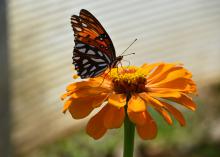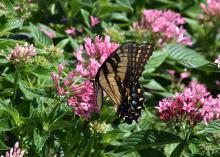Information Possibly Outdated
The information presented on this page was originally released on September 30, 2019. It may not be outdated, but please search our site for more current information. If you plan to quote or reference this information in a publication, please check with the Extension specialist or author before proceeding.
Gary’s list of top butterfly plants
I had the opportunity this past weekend to speak at the Butterflies in the Pass Monarch Festival in Pass Christian. The monarch butterfly may be the most recognized and loved insect in the United States.
Many people closely follow the annual spring and fall migration of monarch butterflies, which rivals the spring and fall migrations of hummingbirds. I met festival attendees who consider the monarch to be America’s butterfly.
Though the theme of the day was monarch butterflies, I spoke about great butterfly plants for the garden that will attract the wide variety of butterflies we have in Mississippi and the Southeast. Besides the monarch, the butterflies I see in my garden include swallowtails, painted ladies, Gulf fritillaries and red admirals.
I realize we’re eventually going to reach the end of our summer season, so use the list I’m about to give you as a planner for next year’s garden. Know that these plants will attract a wide variety of pollinator insects in addition to butterflies, especially a wide variety of bumblebees.
So, here are my top-performing, butterfly-attracting, must-have landscape and garden plants.
Butterfly weed is most known for being the primary forage plant of the monarch butterfly caterpillar. A wide variety of butterfly weed selections are available, but the ones most commonly found at garden centers are Asclepias tuberosa and Asclepias curassavica.
Coneflowers traditionally have large, purple petals with dark center cones. Now there are numerous selections in colors ranging from purple to yellow, red and white. Coneflowers are pollinated primarily by butterflies. These plants have straw-like structures that only a butterfly’s long proboscis can reach while they spread pollen from other flowers.
Salvia is a favorite in my garden because butterflies are attracted to the huge numbers of small, brightly colored flowers that bloom from summer all through fall. There are perennial and annual salvias. It doesn’t matter which you use; just plant some of these plants.
Zinnia elegans -- perhaps my favorite zinnia -- are candy for butterflies. The big and colorful flowers always have butterflies visiting. I find the single flowers get more action, as many of the double-flowered selections seem to have lost nectar production.
Lantana is an amazing plant with gorgeous clusters of small, warm yellow, red and orange flowers. Butterflies love to hover and enjoy the nectar from these dense flower clusters.
Pentas are among our best summer color plants. They act like a magnet for butterflies and hummingbirds because the flowers are a rich source of nectar. Butterfly pentas were named a Mississippi Medallion winner in 2001.
Cuphea, particularly Vermillionaire, not only attracts butterflies, but it also is a bumblebee magnet. This plant can be literally alive with pollinator activity, especially in the fall. Vermillionaire is perennial in coastal counties and is well worth planting as an annual in north Mississippi.
Buddleias have a wide variety of colors and are a great selection for the garden. Their long panicles -- some reaching 12 inches or longer -- display small, individual flowers that butterflies simply can’t resist.
Of course, this list isn’t an all-inclusive list of plants that attract butterflies. There are lots of other great plants to add to your butterfly garden, but these will get you started.





